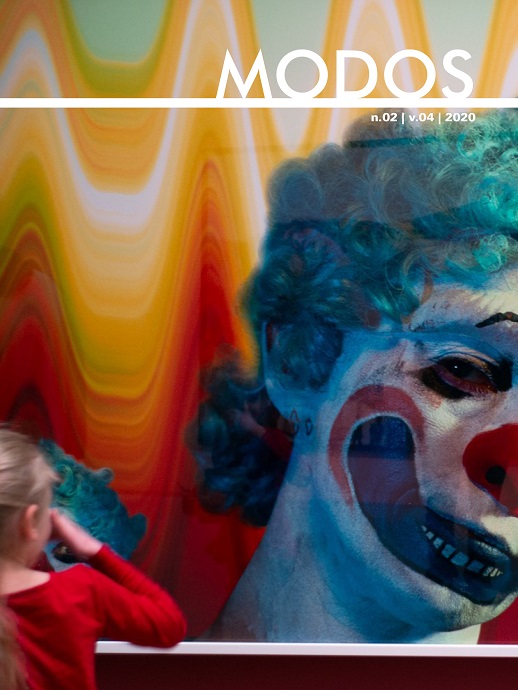Abstract
Starting from an image that is for sale in many Brazilian urban centers and shows the face of a crucified Christ at times with the eyes open, at times with the eyes closed, I present, in this paper, an analysis on the formal transformations that affected this iconographic type. Through this approach, I tried to understand the role of the selected images in their original contexts of production, not separately, but in a dialogue with each other and with the contemporary world. Thus, I took into account some typologies, such as the cross without the figure of Christ, the Christus triumphans, the Christus patiens, the Christus dolens and the dying Christ, which were evaluated in order to understand more deeply the representations of Bom Jesus de Matosinhos and of that crucified Christ who alternately shows the eyes open and closed. In the end, through usual methods employed in Art History, I hope to demonstrate how these images superimposed themselves on each other and even merged, now being considered normal by most Christians.
References
AZEVEDO, C. A. M. Elementos para a iconografia da cruz de Cristo na escultura portuguesa. Humanística e Teologia, IV, 2, 1983, p. 213-234.
BAROCCHI, P. (a cura di). Il carteggio di Michelangelo. 5v. Firenze: Renzo Ristori, 1965-1983.
BELTING, H. Likeness and presence – A history of the image before the era of art. Chicago / London: The University of Chicago Press, 1994.
_____. Por uma antropologia da imagem. Concinnitas, n. 8, 2005, p. 64-78.
_____. Antropología de la imagen. Trad. por Gonzalo María Vélez Espinosa. Buenos Aires: Katz, 2007.
BERBARA, M. C. L. Michelangelo e o Laocoonte – Um aspecto da cristianização do mito antigo no Renascimento Italiano. Dissertação (Mestrado em História). Campinas: Unicamp, 1994.
BORDONE, P. G. Il Codice di Rabbula e i suoi compagni – Su alcuni manoscritti siriaci della Biblioteca Medicea Laurenziana (Mss Pluteo 1.12; Pluteo 1.40; Pluteo 1.56; Pluteo 1.58). Egitto e Vicino Oriente, v. 32, 2009, p. 245-253.
BRÉHIER, L. L’art chrétien – Son développement iconographique des origines à nos jours. Deuxième édition, revue et complétée. Paris: H. Laurens, 1928.
CASSIRER, E. Eidos et eidolon – Le problème du beau et de l’art dans les dialogues de Platon. In: Écrits sur l’art. Paris: Les Éditions du Cerf, 1995, p. 27-52.
CLETO, J. Senhor de Matosinhos – Lenda, história, património. 2ª ed. Matosinhos: Câmara Municipal / Ancima, 2007.
CONDIVI, A. Vita di Michelagnolo Buonarroti. Roma: Antonio Baldo, 1553.
DE TOLNAY, C. Corpus dei disegni di Michelangelo. 4 v. Novara: De Agostini, 1975-1980.
FERNANDES, C. V. Pathos – the bodies of Christ on the Cross. Rhetoric of suffering in wooden sculpture found in Portugal, twelfth-fourteenth centuries. A few examples. RIHA Journal, 0078, 28 nov. 2013. Disponível em: <http://www.riha-journal.org/articles/2013/2013-oct-dec/fernandes-christ>. Acessado em: 03 mar. 2020.
FORCELLINO, M. Michelangelo, Vittoria Colonna e gli “spirituali”: religiosità e vita artistica a Roma negli anni quaranta. Roma: Viella, 2009.
FRANCO MATA, Á. “Crucifixus Dolorosus” – Cristo crucificado, el héroe trágico del cristianismo bajomedieval, en el marco de la iconografía pasional, de la liturgia, mística y devociones. Quintana, n. 1, 2002, p. 13-39. Disponível em: <https://minerva.usc.es/xmlui/handle/10347/6284>. Acessado em: 03 mar. 2020.
FREITAS, A. C. de. Tratado da veneranda et prodigiosa imagem do Senhor de Bouças de Matozinhos. Coimbra: Joseph Ferreyra, 1699. Disponível em: <http://id.bnportugal.gov.pt/bib/rnod/30922>. Acessado em 03: mar. 2020.
GRABAR, A. Martyrium – Recherche sur le culte des reliques et de l’art chrétien antique. (I. Architecture, II. Iconographie). London: Variorum Reprints, 1972.
GRONDIJS, L. H. La mort du Christ et le rit du Zéon. In: Autour de l’iconographie byzantine du Crucifié mort sur la croix. Leiden: E. J. Brill, s/d, p. 51-71.
MANIÉS, A. M. V. O crucificado Bom Jesus de Matosinhos. Estudo Técnico – conservação e restauro de uma escultura medieval. Dissertação (Mestrado em Conservação de Bens Culturais). Porto: Universidade Católica Portuguesa, 2013.
MANIÉS, A.; BARATA, C.; CALVO, A. The Crucified Bom Jesus de Matosinhos. Technical study and conservation of a medieval sculpture. In: LITJENS, S.; SEYMOUR, K. (ed. by). Proceedings of three Interim Meetings of ICOM-CC Working Group “Sculpture, Polychromy, and Architectural Decoration”. Volume III: Polychrome sculpture: Decorative practice and artistic tradition. Tomar: ICOM-CC, 2013, p. 61-72.
MUNDELL MANGO, M. Where was Beth Zagba? Harvard Ukrainian Studies, v. 7, 1983, p. 405-430.
OLIVEIRA, M. A. R. de. O Aleijadinho e o Santuário de Congonhas. Brasília: IPHAN / Monumenta, 2006.
PANOFSKY, E. Idea: a evolução do conceito de belo. São Paulo: Martins Fontes, 2000.
PINTO, A. C. Historia da prodigiosa imagem de Christo crucificado, que com o titulo de Bom Jesus de Bouças se venera no lugar de Matozinhos na Lusitania. Lisboa: Antonio Isidoro da Fonseca, 1737. Disponível em: <https://archive.org/details/historiadaprodig00pint/page/n8/mode/2up>. Acessado em: em 03 mar. 2020.
PINTO FERREIRA, J. A. A Escultura do “Bom Jesus de Bouças” (Nótula Histórica e Etnográfica). Separata do Boletim Cultural da Câmara Municipal do Porto, vol. XXI, n. 1-2, Porto, 1958.
PROSPERI, A. Michelangelo e gli “spirituali”. In: FORCELLINO, Antonio. Michelangelo Buonarroti, storia di una passione eretica. Torino: Einaudi, 2002.
RÉAU, L. Iconographie de l’art chrétien. (Tome Second / Iconographie de la Bible / II – Nouveau Testament). Paris: Presses Universitaires de France, 1957.
SOUSA, M. T. R. de. Oitocentos anos de devoção – A coleção de ex-votos da Misericórdia de Matosinhos. Matosinhos: Santa Casa de Misericórdia do Bom Jesus de Matosinhos, 2005.
VARAZZE, J. de. Legenda Áurea – Vidas de santos. São Paulo: Companhia das Letras, 2003.
VASARI, G. Le vite de’ più eccellenti pittori, scultori e architettori nelle redazioni del 1550 e 1568. (Testo a cura di Rosanna Bettarini / Commento secolare a cura di Paola Barocchi). 6 v. Firenze: Sansoni / S.P.E.S., 1966-1987.
VERNANT, J-P. Œuvres – Religions, rationalités, politique. 2 v. Paris: Éditions Seuil, 2007 (Figuration de l’invisible et catégorie psychologique du double: le “kolossos” (I, p. 533-545); De la présentification de l’invisible à l’imitation de l’apparence (I, p. 546-558); Naissance des images (II, p. 1728-1751); Image, imaginaire, imagination (II, p. 2017-2031).

This work is licensed under a Creative Commons Attribution-NonCommercial-ShareAlike 4.0 International License.
Copyright (c) 2020 MODOS

